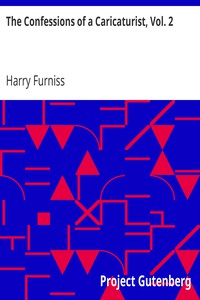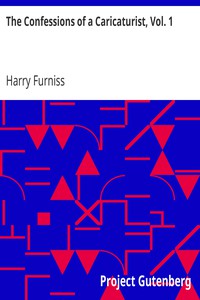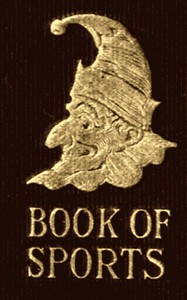The Confessions of a Caricaturist, Vol. 2, Harry Furniss [affordable ebook reader txt] 📗

- Author: Harry Furniss
Book online «The Confessions of a Caricaturist, Vol. 2, Harry Furniss [affordable ebook reader txt] 📗». Author Harry Furniss
"Then how can I paint him?" asked the artist.
"Why, I've just seen your picture of Moses, and surely if you can paint the portrait of a man who died thousands of years ago, you can more easily paint my father, who has only been dead ten years!"
Seeing the sort of man with whom he had to deal, the young artist agreed to paint the defunct gentleman, and the picture in due time was sent home. It was carefully hung on the drawing-room wall, and the newly-blossomed art patron was called in to see it. He gazed at it for some time in silence, his eyes filled with tears, and then, slowly nodding his head, he said softly and reverently, "So that is my father! Ah, how he is changed!"
But out of this lecture comes another story—the story of "The Great Six Toes Trial." I must start at the beginning of its strange, eventful history, the same way as, in my lecture, I began with the origin of portraiture.
Now the late George Augustus Sala, in his leader in the Daily Telegraph on this lecture, accused me of not giving the origin of portraiture. "Mr. Harry Furniss was bold enough to maintain that, although Greek art remained the model art of the world, portraiture had very little to do with it. Mr. Furniss should not tell this story to the prehistoric toad, for that reptile's presumably long memory might enable it to remind the graphic artist that thousands of years ago the art of portraiture was invented by a sentimental young Greek girl, the daughter of a potter of Corinth, Dibutades." In the same[Pg 195] article he sneered at "a whimsical caricaturist lecturing his contemporaries," and in his references to me was about as offensive as he could be.
 G. A. SALA.
G. A. SALA.
The second stage was my letter to the Editor of the Daily Telegraph. That paper not printing it, I sent it, with a note, to the Editor of the Pall Mall Gazette, who gave both letters a prominent position:
"Sir,—Can you find space for the publication of the following letter which I addressed to the Daily Telegraph in answer to their leader in last Friday's issue, as the insignificant paragraph, 'Greek Portraits,' which[Pg 196] alone the Daily Telegraph inserted, in no way states the facts of the case?"
"Sir,—The writer of the leader in your issue of last Friday is guilty of the very fault of which he accuses me. He charges me with not acquainting myself with the subject I treated of in my lecture; he has manifestly not troubled to acquaint himself with that lecture. The ignorance—at any rate, the omissions—that he lays to my door do not exist. Did he expect me in the course of a short hour's lecture to a general audience—which was certainly not prepared for any history or technicalities—to bring forward in my opening sentences the whole story of the rise and development of Greek portraiture? The principal omission of which he complains is the legend of the daughter of Dibutades—calling it an omission because, forsooth, he did not read it in the Times report! But, in point of fact, not only did I give the story at length, but I reproduced on the screen Mortimer's well-known picture of the incident. Surely it is not too much to ask, even for a caricaturist to ask—for such he somewhat scornfully terms me—that when so powerful a personality as a leader writer levels his pen against an individual, however humble, he should not depend upon the report of another newspaper, the exigencies of whose space naturally prevent, it may be assumed, the devotion of more than a column verbatim report to any utterances of a 'mere caricaturist.' But, frankly, does the nature of my own occupation in the arts preclude me from pronouncing a correct judgment on portraits and portraiture? For that, after all, is the burden of your article. Is not an opinion, if correct, as good coming from a bootblack as from a Royal Academician? If so, I submit that mine, if worthy of discussion at all, might at least be ascertained and be considered with respect. If not, then I bring the lecture of Professor Herkomer, A.R.A., published on the very same day as your article, to witness that my judgment was a fair one. By a curious coincidence, he lectured at Leeds on the self-same subject within twenty-four hours of the delivery of my own little lecture; he travelled over much the same ground; brought forward in some instances the very same examples as I, and deduced very much the same conclusions."
I happened to call in at the Garrick Club on my way to the Punch dinner, and there found a copy of the Daily Telegraph containing the leader, on the margin of which was written with the familiar purple ink, in Lewis Wingfield's handwriting, "G.A.S. on Hy. F." Wingfield was Sala's neighbour and friend, so this settled any doubt I had about the authorship of the article I have just referred to. When I showed it to du Maurier, who sat next to me at dinner, he said, "I say, old chap, I'll tell you a capital story about Sala which you might use.[Pg 197] When he was an art student, he tried to get into the Art Schools of the Royal Academy, and for that purpose had to draw the usual head, hand, and foot. When the Examiners counted the toes on the foot Sala had drawn, they found six, so Sala didn't get in, don't you know!" Now, as other journalists had quoted Sala against me, and a Nottingham paper attacked me in a long and rather vulgar and offensive leader, I, finding myself shortly afterwards the guest of the Literary Club in Nottingham, seized the opportunity to reply. I regretted—though I supposed it was flattering to me—to find that quite recently, although I had been treated for many years with the greatest kindness in the Press, I had been rather attacked. "I was proud," I said, "to find that the first person to attack me in the Press was the greatest journalist the Press possessed—Mr. George Augustus Sala." What I really said after this I print side by side with what I was reported to have said:
"In 1851 Mr. Sala painted the pictures upon the walls of an eating saloon, and that probably had given him the taste for cooking which he had evinced ever since." "He (Mr. Furniss) had not the pleasure of Mr. Sala's personal acquaintance, but no one had a greater admiration for him than he had as being a great man in literature. Mr. Sala began life as an artist, and not only so, but he began in that walk of life which he (Mr. Furniss) pursued. He went to Dickens, and wanted to illustrate his books, but Dickens would not have the sketches; afterwards Mr. Sala went into literature, and it was a very good thing for him and for literature that Dickens gave him the refusal that he did. (Hear, hear.)
"Mr. Sala began not only as an artist, but as a caricaturist, and he had to send into the Academy Schools three 'short drawings,' as they were called, of a head, a hand, and a foot. Unfortunately for Mr. Sala, he had six toes upon the foot he drew, and the Examiner, having counted these toes, pointed the matter out to Mr. Sala, who did not get into the Academy Schools, so now he was the Art Critic of the Daily Telegraph. In 1851, Mr. Sala painted the pictures upon the walls of an eating saloon, and that probably had given him the taste for cooking which he had evinced ever since."
The reporter had evidently trusted to his memory, and not to shorthand notes—thus the blunder. I pointed it out, and at once corrected it in a letter printed in the same paper a day or so afterwards. My object in all sincerity was to have a joke—du Maurier's joke—at Sala's expense, but in leading up to it my very complimentary and perfectly accurate parallel illustration of Thackeray was unfortunately, by the reporter's carelessness, attributed to Sala!

This correction was entirely lost sight of by the Press, and I was accused by papers all over the country of having falsely accused him of offering to illustrate Dickens. Papers printed apologies to Sala, and in some cases paid Sala's solicitor money to avoid actions-at-law. I then heard that he was going for me. I found a letter from Burnand to that effect the evening I returned from a lecturing tour. Strange to say, that night Sala and I were both guests of a Medical Society's dinner at the Holborn Restaurant. Both had to make speeches. I spoke before Sala, and referred to a misquotation from a speech I had made in the country, and purposely then and there made the amende honorable, of which he at least understood the meaning. He ignored this altogether, and I now merely mention the incident to show that he was vindictive from the very first. He would not listen to reason. Sir George Lewis, Mr. Labouchere, Mr. Burnand, and other mutual friends failed: Sala remained obdurate. It was freely reported after the verdict[Pg 199] was given that the plaintiff never had any desire to make money out of me, and had specially instructed his counsel not to ask for damages! As a matter of fact, when our mutual friends implored Sala not to proceed with such a trivial and ridiculous action, he admitted that he wanted money, and in conversation with Sir George Lewis—who all through acted as my good friend, and Sala's too, doing all in his power (which is great) to induce Sala to accept my necessary amende,—Sala declined. He had already pocketed several amounts from papers publishing the Nottingham paper's fanciful report, and said to Sir George: "When Friswell libelled me, I got £500 damages; and why should I not be equally successful against Furniss?" "Yes," said the astute Sir George, "but you must remember that I got you that £500, and now I am on the other side."
What I really said, and what I was reported to have said, here I plainly show are two very different things. Still, in the words "and now





Comments (0)